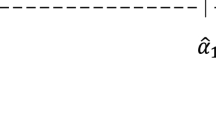Abstract
Under assumptions that will hold for the usual test situation, it is proved that test reliability and variance increase (a) as the average inter-item correlation increases, and (b) as the variance of the item difficulty distribution decreases. As the average item variance increases, the test variance will increase, but the test reliability will not be affected. (It is noted that as the average item variance increases, the average item difficulty approaches .50). In this development, no account is taken of the effect of chance success, or the possible effect on student attitude of different item difficulty distributions. In order to maximize the reliability and variance of a test, the items should have high intercorrelations, all items should be of the same difficulty level, and the level should be as near to 50% as possible.
Similar content being viewed by others
References
Carroll, John B. The effect of difficulty and chance success on correlations between items or between tests.Psychometrika, 1945,10, 1–20.
Dressel, Paul L. Some remarks on the Kuder-Richardson Reliability coefficient.Psychometrika, 1940,5, 305–310.
Ferguson, G. A. The factorial interpretation of test difficulty.Psychometrika, 1941,6, 323–329.
Jackson, R. W. B. and Ferguson, G. A. Studies on the reliability of tests. Bull. No. 12 of the Dept. of Educ. Res., Univer. of Toronto, 371 Bloor St. West, Toronto 5.
Kelley, T. L. Statistical method. New York: Macmillan, 1924.
Kuder, G. F. and Richardson, M. W. The theory of the estimation of test reliability.Psychometrika, 1937,2, 151–160.
Richardson, M. W. The relation of difficulty to the differential validity of a test.Psychometrika, 1936,1, 33–49.
Symonds, P. M. Factors influencing test reliability.J. educ. Psychol., 1928,19, 73–87.
Thurstone, L. L. A method of scaling psychological and educational tests.J. educ. Psychol., 1925,16, 433–451.
Thurstone, L. L. The scoring of individual performance.J. educ. Psychol., 1926,17, 446–457.
Thurstone, T. G. The difficulty of a test and its diagnostic value.J. educ. Psychol., 1932,23, 335–343.
Author information
Authors and Affiliations
Additional information
The desirability of determining this relationship has been indicated by previous writers. Work on the present paper arose out of some problems raised by Dr. Herbert S. Conrad in connection with an analysis of aptitude tests.
On leave for Government war research from the Psychology Department, University of Chicago.
Rights and permissions
About this article
Cite this article
Gulliksen, H. The relation of item difficulty and inter-item correlation to test variance and reliability. Psychometrika 10, 79–91 (1945). https://doi.org/10.1007/BF02288877
Issue Date:
DOI: https://doi.org/10.1007/BF02288877




